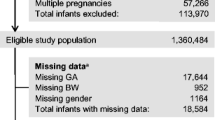Abstract
SGA (small for gestational age) is widely used to identify high-risk infants, although with inconsistent definitions. Cut points range from 2.5th to 10th percentile of birthweight-for-gestational age. We used receiver operator characteristic curves (ROC) to identify the cut point with maximum sensitivity and specificity (Youden Index), and the area under the curve (AUC), which assesses overall discriminating power. Analysis was conducted on 3,836,034 US births (2015) and 292,279 Norwegian births (2010–14). Birthweight percentiles were calculated using exact birthweights at each week of gestational age, and then summarized across gestational ages. We also conducted a companion analysis of gestational age itself to consider the predictive power of gestational week of birth. Outcomes were neonatal mortality and cerebral palsy, both strongly associated with birthweight. Birthweight percentiles performed poorly in all analyses. The AUC for birthweight percentiles as a discriminator of neonatal mortality was 60% (where 50% is no better than a coin-toss). At such low discrimination, the Youden Index provides no useful SGA cut point. Results in Norway were virtually identical, with an AUC of 58%. The AUC with cerebral palsy as the outcome was even lower, at 54%. In contrast, gestational age had an AUC of 85% as a predictor of neonatal mortality, with < 37 weeks as the optimum cut point. SGA provides surprisingly poor identification of at-risk infants, while gestational age performs well. Similar results in two countries that differ in mean birthweight, percent preterm, and neonatal mortality suggest robustness across populations.




Similar content being viewed by others
Data availability
The US data are publicly available. The Norway data are protected by law and may be accessed only with permission. Data providing the basis for primary analyses have been included in the tables.
Code availability
We used routinely available software described in text.
References
Web of. Science, accessed 31 March 2021.
Zeve D, Regelmann MO, Holzman IR, Rapaport R. Small at birth, but how small? The definition of SGA revisited. Horm Res Paediatr. 2016;86:357–60.
Basso O, Wilcox AJ. Mortality risk among preterm babies: immaturity vs. underlying pathology. Epidemiology. 2010;21(4):521–7.
Talge NM, Mudd LM, Sikorskii A, Basso O. United States birth weight reference corrected for implausible gestational age estimates. Pediatrics. 2014;133(5):844–53.
Cortese M, Moster D, Wilcox AJ. Term birth weight and neurodevelopmental outcomes. Epidemiology. 2021;32(4):583–90.
Moster D, Lie RT, Irgens LM, Bjerkedal T, Markestad T. The association of Apgar score with subsequent death and cerebral palsy: a population-based study in term infants. J Pediatr. 2001;138(6):798–803l.
Tape TG. Interpreting. diagnostic tests, http://gim.unmc.edu/dxtests/roc3.htm (accessed 23 March 2021).
Goldenberg RL, Hoffman HJ, Foster JM, et al. Intrauterine growth retardation: standards for diagnosis. Am J Obstet Gynecol. 1989;161:271–7.
Martin JA, Osterman MJK, Kimeyer SE, Gregory ECW. Measuring gestational age in vital statistics data: transitioning to the obstetric estimate. Natl Vital Stat Rep. 2015;64(5):1–20.
Wilcox AJ. On the importance, and unimportance, of birth weight. Int J Epidemiol. 2001;30(6):1233–41.
Divon MY. Fetal growth restriction: screening and diagnosis. UpToDate. Accessed 3 May 2021.
WHO Expert Committee. Physical Status: The use and interpretation of anthropometry: Report of a WHO Expert Committee. Geneva. World Health Organization; 1995.
Clayton PE, Cianfarani S, Czernichow P, Johannsson G, Rapaport R, Rogol A. A consensus statement of the International Societies of Pediatric endocrinology and the Growth Hormone Research Society. J Clin Endocrinol Metab. 2007;92(3):804–10.
Anctil AO, Joshi GB, Lucas WE, Little WA, Callagan DA. Prematurity: a more precise approach to identification. Obstet Gynecol. 1964;24(5):716–21.
Budin P. Sickly infants. La Presse Med. 1902;97:1155–57.
Basso O, Wilcox AJ, Weinberg CR. Birth weight and mortality: causality or confounding? Am J Epidemiol. 2006;164(4):303–11.
Kabiri D, et al. Prediction of adverse perinatal outcome by fetal biometry: comparison of customized and population-based standards. Ultrasound Obstet Gynecol. 2020;55:177–88.
Wilkinson D, Verhagen E, Johansson S. Thresholds for resuscitation of extremely preterm infants in the UK, Sweden, and Netherlands. Pediatrics. 2018;1142(s1):S574–S584.
Mandy GT. Infants with fetal (intrauterine) growth restriction. UpToDate. Accessed 10 Dec 2020.
Hutcheon JA, Riddell CA, Himes KP. A new approach for classifying fetal growth restriction. Epidemiol published ahead of print. https://doi.org/10.1097/EDE.0000000000001399.
Acknowledgements
The authors thank Drs. Quaker Harmon, Kelly Ferguson, Jennifer Hutcheon, and Jon Snowden for helpful comments on earlier drafts of this paper.
Funding
This project was supported by the Intramural Program of the National Institute of Environmental Health Sciences, NIH, the German Research Council, the Gerda Meyer Nyquist Gulbrandson and Gerdt Meyer Nyquist’s Fund, and the Norwegian SIDS and Stillbirth Society. All authors are independent from funders and had full access to all of the data (including statistical reports and tables) in the study. All authors take responsibility for the integrity of the data and the accuracy of the data analysis.
Author information
Authors and Affiliations
Contributions
All authors meet the Vancouver criteria for authorship and have approved this version of the manuscript.
Corresponding author
Ethics declarations
Conflict of interest
The authors have no conflicts of interest.
Ethics approval
Use of the Norwegian data was approved by the Regional Committee for Medical and Health Research Ethics in Norway and by the government agencies responsible for the registries.
Consent to participate
Data were based on national registries collected under law.
Consent for publication
No consent for publication required.
Additional information
Publisher’s Note
Springer Nature remains neutral with regard to jurisdictional claims in published maps and institutional affiliations.
Supplementary Information
Below is the link to the electronic supplementary material.
Rights and permissions
About this article
Cite this article
Wilcox, A.J., Cortese, M., McConnaughey, D.R. et al. The limits of small-for-gestational-age as a high-risk category. Eur J Epidemiol 36, 985–991 (2021). https://doi.org/10.1007/s10654-021-00810-z
Received:
Accepted:
Published:
Issue Date:
DOI: https://doi.org/10.1007/s10654-021-00810-z




